
Flying Cloud was a clipper ship that set the world's sailing record for the fastest passage between New York and San Francisco, 89 days 8 hours. The ship held this record for over 130 years, from 1854 to 1989.

Donald McKay was a Nova Scotian-born American designer and builder of sailing ships, famed for his record-setting extreme clippers.

Stag Hound was launched on December 7, 1850, in East Boston, Massachusetts. Designed by shipbuilder Donald McKay for the California trade, she was briefly the largest merchant ship in the world. She was in active service from 1851 until her total loss in 1861.

Surprise was a California clipper built in East Boston in 1850. It initially rounded Cape Horn to California, but the vessel's owners, A. A. Low & Brother, soon found that the vessel performed well in Far Eastern waters. From that point onward the vessel spent much of her working life in the China trade, although the vessel also made three trips from the East Coast of the United States to California.
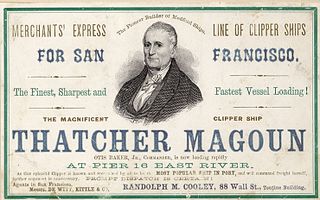
The Thatcher Magoun was an extreme clipper launched in 1855. She was built in shipyards on the Mystic River at Medford, Massachusetts by shipbuilder Thatcher Magoun. Magoun died the year she was launched, and the ship was named after him.
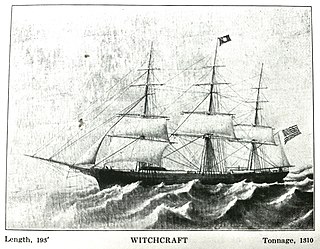
Witchcraft was a clipper built in 1850 for the California and China trade. She made record passages from Rio de Janeiro to San Francisco, and from San Francisco to Callao, Peru.

Herald of the Morning was one of the few clipper ships with a passage to San Francisco in less than 100 days.

The Memnon was the first clipper ship to arrive in San Francisco after the Gold Rush, and the only clipper to arrive in San Francisco before 1850. Built in 1848, she made record passages to San Francisco and to China, and sailed in the first clipper race around Cape Horn.

Hornet was an 1851 extreme clipper in the San Francisco trade, famous for its race with Flying Cloud.

Race Horse was an 1850 clipper barque. She set a record of 109 days from New York to San Francisco during the first Clipper Race around the Horn.
Antelope was a medium clipper built in 1851 in Medford, near Boston, Massachusetts. She sailed in the San Francisco, China, and Far East trades, and was known for her fine finish work and for her crew's escape from pirates. She is often called Antelope of Boston to distinguish her from the extreme clipper Antelope of New York launched in 1852.
An extreme clipper was a clipper designed to sacrifice cargo capacity for speed. They had a bow lengthened above the water, a drawing out and sharpening of the forward body, and the greatest breadth further aft. In the United States, extreme clippers were built in the period 1845 to 1855. British-built extreme clippers include vessels built over the period 1854 to 1870.

Westward Ho! was an 1852 clipper that made two very fast passages to San Francisco; 100 days from Boston and New York City. She had a very close race with Neptune's Car, and ended her days in the coolie trade.
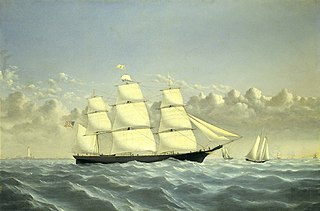
Golden West was an 1852 extreme clipper built by Paul Curtis. The ship had a very active career in the California trade, the guano trade, the coolie trade, the Far East, and Australia. She made a record passage between Japan and San Francisco in 1856.
A medium clipper is a type of clipper designed for both cargo carrying capacity and speed. An evolutionary adaptation of the extreme clipper, the medium clipper had been invented by 1851, when the hull type appeared in U.S. shipyards. Medium clippers continued to be built until 1873, when Pilgrim, one of the last known medium clipper ships to be built, was launched by Joshua T. Foster from the shipyards of Medford, Massachusetts.

Witch of the Wave was a long-lived extreme clipper in the California trade, with a sailing life of over 34 years. In 1851, she sailed from Calcutta to Boston in 81 days, setting a record. It was renamed the Electra in 1871.
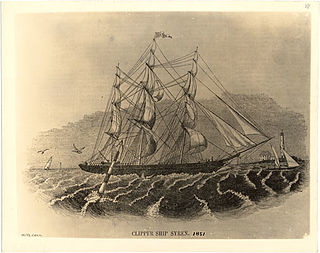
Syren was the longest lived of all the clipper ships, with a sailing life of 68 years 7 months. She sailed in the San Francisco trade, in the Far East, and transported whaling products from Hawaii and the Arctic to New Bedford.

Shooting Star was an extreme clipper built in 1851 near Boston, in Medford, Massachusetts. She was the first "real clipper" to be built in Medford, and sailed in the San Francisco, China, and Far East trades. According to Howe and Matthews, she was known as "one of the fastest of the small clippers".
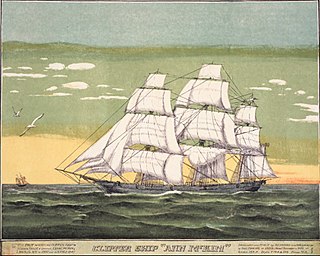
Ann McKim was one of the early true clipper ships, designed to meet the increasing demand for faster cargo transportation between the United States and China in the early 1840s. The opening of new Treaty ports in the East allowed American merchants greater access to trade with China, leading to the need for ships that could move cargo more quickly than traditional merchant ships. Ann McKim was one of the ships that had answered the demand in the early years and sailed between New York and China in 1840–1842, until newer and faster cargo-carriers, such as the nearly 600-ton clipper Houqua, the 598-ton China packet Helena, Witch of theWave, and Rainbow started dominating the shipping world of the US-China trade and Ann McKim was shifted back to the South American trade routes.

The Moses H. Grinnell was a 19th-century pilot boat built in 1850 for the New York maritime pilots. She was designed by the yacht designer George Steers. The Grinnell was the first pilot boat to feature a fully developed concave clipper-bow, which was to become the New York schooner-rigged pilot boat's trade mark. This new design was the basis for the celebrated yacht America.

















